Landscape Planning Integrated Approaches to Support Post-Wildfire Restoration in Natural Protected Areas: The Vesuvius National Park Case Study
Abstract
:1. Introduction
- take into account the different context components, different objectives and different stakeholders “points of view”;
- make the decision-making process more transparent and, thus the decisions more sharable;
- make timely and rapid responses, considering both biotic and abiotic component requirements.
2. Materials and Methods
2.1. Study Area
2.2. Steps in Method
- Development of the “states” using the S-MCDA methodology to identify PIAs.
- The “impact” analysis, including the assessment of wildfires damage, through the ecosystem services approach.
2.3. Identification of Priority Intervention Areas via Spatial-Multicriteria Decision Analysis
- Regarding park accessibility, the aim was to ensure tourism and recreational, cultural, inspirational and educational purposes;
- Regarding suitable conditions, the aim was to protect nature and conserve biodiversity within the park, especially in the post-fire phase, favoring the restoration of ecosystem integrity and resilience;
- Regarding agricultural and forestry non-wood products (mainly the ceased collection of stone pine nuts), the aim was to follow local community demand, including subsistence resource use.
2.4. Ecosystem Services Valuation
- Definition of ES monetary values (€/ha per year, as unique values for each land cover class, according to basic transfer methods—BTM), and their literature reference;
- Adjustment of the ES constant values, referring to local context-specific conditions, by means of the identification and processing of specific coefficients (with the panel of expert support and spatially modelling and biophysical assessment);
- Processing and comparing the results in the pre-wildfire 2017 and post-wildfire 2018 phases, highlighting changes in values according to spatial-explicit estimation methods (SEM).
3. Results
3.1. Identification of Priority Intervention Areas Results
3.2. Ecosystem Services Valuation Results
- with regard to the PIAs, they allow for the identifying of a limited area in which to concentrate, in the early post-fire phases, resources of means and money to favour the re-activation (spontaneous or guided) of ecosystem recovery processes (660 ha against the 3350 ha covered by wildfires and the 1200 ha with a high and very high degree of fire severity);
- with regard to the ESs assessment, they provide objective values to be discussed, both in terms of natural heritage to be protected and enhanced, and also in relation to neighboring territories and in terms of estimating the damage and raising awareness of local communities and decision-makers on the wildfire risk and the protected areas management;
- with regard to the ES mapping, they show a significant coincidence between the PIAs and the areas with the greatest damage of ESs, highlighting the strategic role of PIAs from the perspective of ecosystem recovery.
4. Discussion
4.1. Identification of Priority Intervention Areas
- The intersection map between accessibility and nature high-value zones, which highlights the areas in which accessibility and touristic use are closely connected with the natural value of the context and allows for the recognition that park accessibility is linked to natural conditions, but the natural conditions are not necessarily linked to the fruition of the area.
- The intersection map between high-value accessibility and the agroforestry production areas shows that, in the current park fruition circuits, there is no suitable exploitation of productive resources. The awareness of the important and high-quality agricultural production in the study areas, underlined by brands and certification, can support the decision-makers in the planning of paths/circuits/internal roads network integration with dedicated food and wine itineraries.
- The intersection of the three areas of interest maps ultimately shows the areas (about 700 ha) which, under ordinary management of the park, may be considered the best in terms of fruition, biodiversity conditions and agro-food production, with regard to supporting the local socio-economic development and its population.
4.2. Ecosystem Services Evaluation Land-Use/Landscape
5. Conclusions
Supplementary Materials
Author Contributions
Funding
Institutional Review Board Statement
Informed Consent Statement
Conflicts of Interest
References
- Keeley, J.E.; Bond, W.J.; Bradstock, R.A.; Pausas, J.G.; Rundel, P.W. Fire in Mediterranean Ecosystems: Ecology, Evolution and Management; Cambridge University Press: New York, NY, USA, 2011. [Google Scholar]
- Tedim, F.; Leone, V.; Amraoui, M.; Bouillon, C.; Coughlan, M.R.; Delogu, G.M.; Fernandes, P.M.; Ferreira, C.; McCaffrey, S.; McGee, T.K.; et al. Defining Extreme Wildfire Events: Difficulties, Challenges, and Impacts. Fire 2018, 1, 9. [Google Scholar] [CrossRef] [Green Version]
- Pausas, J.G.; Keeley, J.E. Wildfires as an ecosystem service. Front. Ecol. Environ. 2019, 17, 289–295. [Google Scholar] [CrossRef] [Green Version]
- McLauchlan, K.K.; Higuera, P.E.; Miesel, J.; Rogers, B.M.; Schweitzer, J.; Shuman, J.K.; Tepley, A.J.; Varner, J.M.; Veblen, T.T.; Adalsteinsson, S.A.; et al. Fire as a fundamental ecological process: Research advances and frontiers. J. Ecol. 2020, 108, 2047–2069. [Google Scholar] [CrossRef]
- Pausas, J.G.; Llovet, J.; Rodrigo, A.; Vallejo, R. Are wildfires a disaster in the Mediterranean basin?—A review. Int. J. Wildland Fire 2008, 17, 713–723. [Google Scholar] [CrossRef]
- Bowman, D.M.; Balch, J.K.; Artaxo, P.; Bond, W.J.; Carlson, J.M.; Cochrane, M.A.; D’antonio, C.M.; Defries, R.S.; Doyle, J.C.; Harrison, S.P.; et al. Fire in the Earth system. Science 2009, 324, 481–484. [Google Scholar] [CrossRef]
- Harvey, B.J. Human-caused climate change is now a key driver of forest fire activity in the western United States. Proc. Natl. Acad. Sci. USA 2016, 113, 11649–11650. [Google Scholar] [CrossRef] [Green Version]
- Boer, M.M.; Nolan, R.H.; De Dios, V.R.; Clarke, H.; Price, O.F.; Bradstock, R.A. Changing weather extremes call for early warning of potential for catastrophic fire. Earth’s Future 2017, 5, 1196–1202. [Google Scholar] [CrossRef]
- Stevens-Rumann, C.S.; Kemp, K.B.; Higuera, P.E.; Harvey, B.J.; Rother, M.T.; Donato, D.C.; Morgan, P.; Veblen, T.T. Evidence for declining forest resilience to wildfires under climate change. Ecol. Lett. 2018, 21, 243–252. [Google Scholar] [CrossRef]
- Urbieta, I.R.; Zavala, G.; Bedia, J.; Gutiérrez, J.M.; San Miguel-Ayanz, J.; Camia, A.; Keeley, J.E.; Moreno, J.M. Fire activity as a function of fire–weather seasonal severity and antecedent climate across spatial scales in southern Europe and Pacific western USA. Environ. Res. Lett. 2015, 10, 114013. [Google Scholar] [CrossRef] [Green Version]
- Oliveira, S.; Félix, F.; Nunes, A.; Lourenço, L.; Laneve, G.; Sebastián-López, A. Mapping wildfire vulnerability in Mediterranean Europe. Testing a stepwise approach for operational purposes. J. Environ. Manag. 2018, 206, 158–169. [Google Scholar] [CrossRef]
- Morvan, D. Wildfires modelling: Short overview, challenges and perspectives. J. Combust. Soc. Jpn. 2019, 61, 120–125. [Google Scholar]
- Moinuddin, K.A.M.; Sutherland, D. Modelling of tree fires and fires transitioning from the forest floor to the canopy with a physics-based model. Math. Comput. Simul. 2020, 175, 81–95. [Google Scholar] [CrossRef]
- Chuvieco, E. (Ed.) Earth Observation of Wildland Fires in Mediterranean Ecosystems; Springer: Dordrecht, The Netherlands, 2009; pp. 129–148. [Google Scholar]
- Millar, C.I.; Stephenson, N.L. Temperate forest health in an era of emerging megadisturbance. Science 2015, 349, 823–826. [Google Scholar] [CrossRef] [PubMed]
- Bowman, D.M.; Williamson, G.J.; Abatzoglou, J.T.; Kolden, C.A.; Cochrane, M.A.; Smith, A.M. Human exposure and sensitivity to globally extreme wildfire events. Nat. Ecol. Evol. 2017, 1, 0058. [Google Scholar] [CrossRef]
- Chuvieco, E.; Aguado, I.; Yebra, M.; Nieto, H.; Salas, J.; Martín, M.P.; Vilar, L.; Martínez, J.; Martín, S.; Ibarra, P.; et al. Development of a framework for fire risk assessment using remote sensing and geographic information system technologies. Ecol. Model. 2010, 221, 46–58. [Google Scholar] [CrossRef]
- Marino, E.; Hernando, C.; Planelles, R.; Madrigal, J.; Guijarro, M.; Sebastián, A. Forest fuel management for wildfire prevention in Spain: A quantitative SWOT analysis. Int. J. Wildland Fire 2014, 23, 373–384. [Google Scholar] [CrossRef]
- Meira-Castro, A.; Shakesby, R.A.; Marques, J.E.; Doerr, S.H.; Meixedo, J.P.; Teixeira, J.; Chaminé, H.I. Effects of prescribed fire on surface soil in a Pinus pinaster plantation, northern Portugal. Environ. Earth Sci. 2015, 73, 3011–3018. [Google Scholar] [CrossRef] [Green Version]
- Lasanta, T.; Khorchani, M.; Pérez-Cabello, F.; Errea, P.; Sáenz-Blanco, R.; Nadal-Romero, E. Clearing shrubland and extensive livestock farming: Active prevention to control wildfires in the Mediterranean mountains. J. Environ. Manag. 2018, 227, 256–266. [Google Scholar] [CrossRef]
- Geldmann, J.; Barnes, M.; Coad, L.; Craigie, I.D.; Hockings, M.; Burgess, N.D. Effectiveness of terrestrial protected areas in reducing habitat loss and population declines. Biol. Conserv. 2013, 161, 230–238. [Google Scholar] [CrossRef]
- Molina, J.R.; Silva, F.R.Y.; Herrera, M.Á. Integrating economic landscape valuation into Mediterranean territorial planning. Environ. Sci. Policy 2016, 56, 120–128. [Google Scholar] [CrossRef]
- Dudley, N. (Ed.) Guidelines for Applying Protected Area Management Categories; IUCN: Gland, Switzerland, 2008; Available online: https://www.iucn.org/theme/protected-areas/about (accessed on 14 July 2020).
- Bottero, M.; Comino, E.; Duriavig, M.; Ferretti, V.; Pomarico, S. The application of a Multicriteria Spatial Decision Support System (MCSDSS) for the assessment of biodiversity conservation in the Province of Varese (Italy). Land Use Policy 2013, 30, 730–738. [Google Scholar] [CrossRef]
- Dudley, N.; Stolton, S. Defining Protected Areas: An International Conference in Almeria, Spain; IUCN: Gland, Switzerland, 2008. [Google Scholar]
- IUCN WCPA. Guidelines for Applying Protected Area Management Categories Including IUCN WCPA Best Practice Guidance on Recognising Protected Areas and Assigning Management Categories and Governance Types. 2008. Available online: https://www.iucn.org/theme/protected-areas/about/protected-areas-categories/category-ii-national-park (accessed on 18 January 2022).
- San-Miguel-Ayanz, J.; Durrant, T.; Boca, R.; Libertà, G.; Branco, A.; de Rigo, D.; Ferrari, D.; Maianti, P.; Vivancos, T.A.; Schulte, E.; et al. Forest Fires in Europe, Middle East and North Africa. 2017. Available online: https://www.driver-project.eu/forest-fires-in-europe-middle-east-and-north-africa-2017-the-new-jrc-report/ (accessed on 30 April 2021).
- Alcasena, F.J.; Ager, A.A.; Bailey, J.D.; Pineda, N.; Vega-García, C. Towards a comprehensive wildfire management strategy for Mediterranean areas: Framework development and implementation in Catalonia, Spain. J. Environ. Manag. 2019, 231, 303–320. [Google Scholar] [CrossRef] [PubMed]
- Qureshi, M.E.; Harrison, S.R.; Wegener, M.K. Validation of multicriteria analysis models. Agric. Syst. 1999, 62, 105–116. [Google Scholar] [CrossRef]
- Mansourian, S.; Vallauri, D. (Eds.) Forest Restoration in Landscapes: Beyond Planting Trees; Springer Science & Business Media: Berlin/Heidelberg, Germany, 2005. [Google Scholar]
- Montiel Molina, C.; Galiana-Martín, L. Fire scenarios in Spain: A territorial approach to proactive fire management in the context of global change. Forests 2016, 7, 273. [Google Scholar] [CrossRef]
- Montiel-Molina, C.; Vilar, L.; Romão-Sequeira, C.; Karlsson, O.; Galiana-Martín, L.; Madrazo-García de Lomana, G.; Palacios-Estremera, M.T. Have historical land use/land cover changes triggered a fire regime shift in central Spain? Fire 2019, 2, 44. [Google Scholar] [CrossRef] [Green Version]
- Sequeira, C.R.; Molina, C.M.; Rego, F.C. Landscape-based fire scenarios and fire types in the Ayllón massif (Central Mountain Range, Spain), 19th and 20th centuries. Cuad. Investig. Geográfica/Geogr. Res. Lett. 2020, 46, 103–126. [Google Scholar] [CrossRef] [Green Version]
- Nijkamp, P. Multicriteria analysis: A decision support system for sustainable environmental management. In Economy and Ecology: Towards Sustainable Development; Springer: Dordrecht, The Netherlands, 1989; pp. 203–220. [Google Scholar]
- Koschke, L.; Fürst, C.; Frank, S.; Makeschin, F. A multi-criteria approach for an integrated land-cover-based assessment of ecosystem services provision to support landscape planning. Ecol. Indic. 2012, 21, 54–66. [Google Scholar] [CrossRef]
- Boggia, A.; Massei, G.; Pace, E.; Rocchi, L.; Paolotti, L.; Attard, M. Spatial multicriteria analysis for sustainability assessment: A new model for decision making. Land Use Policy 2018, 71, 281–292. [Google Scholar] [CrossRef] [Green Version]
- Malczewski, J. GIS-based multicriteria decision analysis: A survey of the literature. Int. J. Geogr. Inf. Sci. 2006, 20, 703–726. [Google Scholar] [CrossRef]
- Romano, G.; Dal Sasso, P.; Liuzzi, G.T.; Gentile, F. Multi-criteria decision analysis for land suitability mapping in a rural area of Southern Italy. Land Use Policy 2015, 48, 131–143. [Google Scholar] [CrossRef]
- Depietri, Y. The social–ecological dimension of vulnerability and risk to natural hazards. Sustain. Sci. 2020, 15, 587–604. [Google Scholar] [CrossRef]
- Bui, D.T.; Bui, Q.T.; Nguyen, Q.P.; Pradhan, B.; Nampak, H.; Trinh, P.T. A hybrid artificial intelligence approach using GIS-based neural-fuzzy inference system and particle swarm optimization for forest fire susceptibility modeling at a tropical area. Agric. For. Meteorol. 2017, 233, 32–44. [Google Scholar]
- Navarro, G.; Caballero, I.; Silva, G.; Parra, P.C.; Vázquez, Á.; Caldeira, R. Evaluation of forest fire on Madeira Island using Sentinel-2A MSI imagery. Int. J. Appl. Earth Obs. 2017, 58, 97–106. [Google Scholar] [CrossRef] [Green Version]
- Ianni, E.; Geneletti, D. Applying the ecosystem approach to select priority areas for forest landscape restoration in the Yungas, Northwestern Argentina. Environ. Manag. 2010, 46, 748–760. [Google Scholar] [CrossRef] [PubMed]
- Moreira, F.; Viedma, O.; Arianoutsou, M.; Curt, T.; Koutsias, N.; Rigolot, E.; Barbati, A.; Corona, P.; Vaz, P.; Xanthopoulos, G.; et al. Landscape–wildfire interactions in southern Europe: Implications for landscape management. J. Environ. Manag. 2011, 92, 2389–2402. [Google Scholar] [CrossRef] [Green Version]
- Molina, J.R.; Moreno, R.; Castillo, M.; Silva, F.R.Y. Economic susceptibility of fire-prone landscapes in natural protected areas of the southern Andean Range. Sci. Total Environ. 2018, 619, 1557–1565. [Google Scholar] [CrossRef]
- McWethy, D.B.; Schoennagel, T.; Higuera, P.E.; Krawchuk, M.; Harvey, B.J.; Metcalf, E.C.; Schultz, C.; Miller, C.; Metcalf, A.L.; Buma, B.; et al. Rethinking resilience to wildfire. Nat. Sustain. 2019, 2, 797–804. [Google Scholar] [CrossRef]
- Marey-Perez, M.; Loureiro, X.; Corbelle-Rico, E.J.; Fernández-Filgueira, C. Different strategies for resilience to wildfires: The experience of collective land ownership in Galicia (Northwest Spain). Sustainability 2021, 13, 4761. [Google Scholar] [CrossRef]
- Chaplin-Kramer, R.; Sharp, R.P.; Weil, C.; Bennett, E.M.; Pascual, U.; Arkema, K.K.; Brauman, K.A.; Bryant, B.P.; Guerry, A.D.; Haddad, N.M.; et al. Global modeling of nature’s contributions to people. Science 2019, 366, 255–258. [Google Scholar] [CrossRef]
- Fisher, B.; Turner, R.K.; Morling, P. Defining and classifying ecosystem services for decision making. Ecol. Econ. 2019, 68, 643–653. [Google Scholar] [CrossRef] [Green Version]
- Rozas-Vasquez, D.; Fuerst, C.; Geneletti, D. Integrating ecosystem services in spatial planning and strategic environmental assessment: The role of the cascade model. Environ. Impact. Asses. 2019, 78, 106291. [Google Scholar] [CrossRef]
- MEA: Millenium Ecosystem Assessment. Ecosystems and Human Well-Being; Island Press: Washington, DC, USA; World Resources Institute: Washington, DC, USA, 2005; Volume 5, p. 563. [Google Scholar]
- TEEB Foundations. The Economics of Ecosystems and Biodiversity: Ecological and Economic Foundations; Earthscan: London, UK; Washington, DC, USA, 2010. [Google Scholar]
- Plieninger, T.; Torralba, M.; Hartel, T.; Fagerholm, N. Perceived ecosystem services synergies, trade-offs, and bundles in European high nature value farming landscapes. Landsc. Ecol. 2019, 34, 1565–1581. [Google Scholar] [CrossRef]
- Wei, H.; Fan, W.; Lu, N.; Xu, Z.; Liu, H.; Chen, W.; Ulgiati, S.; Wang, X.; Dong, X. Integrating Biophysical and Sociocultural Methods for Identifying the Relationships between Ecosystem Services and Land Use Change: Insights from an Oasis Area. Sustainability 2019, 11, 2598. [Google Scholar] [CrossRef] [Green Version]
- Scolozzi, R.; Morri, E.; Santolini, R. Delphi-based change assessment in ecosystem service values to support strategic spatial planning in Italian landscapes. Ecol. Indic. 2012, 21, 134–144. [Google Scholar] [CrossRef]
- Costanza, R.; De Groot, R.; Sutton, P.; Van der Ploeg, S.; Anderson, S.J.; Kubiszewski, I.; Farber, S.; Turner, R.K. Changes in the global value of ecosystem services. Glob. Environ. Chang. 2014, 26, 152–158. [Google Scholar] [CrossRef]
- Kubiszewski, I.; Costanza, R.; Anderson, S.; Sutton, P. The future value of ecosystem services: Global scenarios and national implications. In Environmental Assessments; Edward Elgar Publishing: Northampton, MA, USA, 2020. [Google Scholar]
- Mose, I.; Weixlbaumer, N. A new paradigm for protected areas in Europe. In Protected Areas and Regional Development in Europe. Towards a New Model for the 21st Century; Routledge: London, UK, 2007; pp. 3–20. [Google Scholar]
- Jones, K.R.; Venter, O.; Fuller, R.A.; Allan, J.R.; Maxwell, S.L.; Negret, P.J.; Watson, J.E. One-third of global protected land is under intense human pressure. Science 2018, 360, 788–791. [Google Scholar] [CrossRef] [Green Version]
- Guerra, C.A.; Rosa, I.M.; Pereira, H.M. Change versus stability: Are protected areas particularly pressured by global land cover change? Landsc. Ecol. 2019, 34, 2779–2790. [Google Scholar] [CrossRef] [Green Version]
- Jones-Walters, L.; Čivić, K. European protected areas: Past, present and future. J. Nat. Conserv. 2013, 21, 122–124. [Google Scholar] [CrossRef]
- Smeets, E.; Weterings, R. Environmental Indicators: Typology and Overview; European Environment Agency: Copenhagen, Denmark, 1999. [Google Scholar]
- Maxim, L.; Spangenberg, J.H.; O’Connor, M. An analysis of risks for biodiversity under the DPSIR framework. Ecol. Econ. 2009, 69, 12–23. [Google Scholar] [CrossRef]
- Galler, C.; Albert, C.; von Haaren, C. From regional environmental planning to implementation: Paths and challenges of integrating ecosystem services. Ecosyst. Serv. 2016, 18, 118–129. [Google Scholar] [CrossRef]
- Moss, E.D.; Evans, D.M.; Atkins, J.P. Investigating the impacts of climate change on ecosystem services in UK agro-ecosystems: An application of the DPSIR framework. Land Use Policy 2021, 105, 105394. [Google Scholar] [CrossRef]
- Zebardast, L.; Salehi, E.; Afrasiabi, H. Application of DPSIR Framework for Integrated Environmental Assessment of Urban Areas: A Case Study of Tehran. Int. J. Environ. Res. 2015, 9, 445–456. [Google Scholar]
- Relvas, H.; Miranda, A.I. Application of the DPSIR framework to air quality approaches. Air Qual. Atmos. Health 2018, 11, 1069–1079. [Google Scholar] [CrossRef]
- Wang, W.; Sun, Y.; Wu, J. Environmental warning system based on the DPSIR model: A practical and concise method for environmental assessment. Sustainability 2018, 10, 1728. [Google Scholar] [CrossRef] [Green Version]
- Saulino, L.; Rita, A.; Migliozzi, A.; Maffei, C.; Allevato, E.; Garonna, A.P.; Saracino, A. Detecting burn severity across mediterranean forest types by coupling medium-spatial resolution satellite imagery and field data. Remote Sens. 2020, 12, 741. [Google Scholar] [CrossRef] [Green Version]
- Silvestro, R.; Saulino, L.; Cavallo, C.; Allevato, E.; Pindozzi, S.; Cervelli, E.; Conti, P.; Mazzoleni, S.; Saracino, A. The Footprint of Wildfires on Mediterranean Forest Ecosystem Services in Vesuvius National Park. Fire 2021, 4, 95. [Google Scholar] [CrossRef]
- Cowling, R.M.; Pressey, R.L.; Sims-Castley, R.; Le Roux, A.; Baard, E.; Burgers, C.J.; Palmer, G. The expert or the algorithm?—Comparison of priority conservation areas in the Cape Floristic Region identified by park managers and reserve selection software. Biol. Conserv. 2003, 112, 147–167. [Google Scholar] [CrossRef]
- Geneletti, D.; van Duren, I. Protected area zoning for conservation and use: A combination of spatial multicriteria and multiobjective evaluation. Landsc. Urban Plan. 2008, 85, 97–110. [Google Scholar] [CrossRef]
- Ruiz-Gallardo, J.R.; Castaño, S.; Calera, A. Application of remote sensing and GIS to locate priority intervention areas after wildland fires in Mediterranean systems: A case study from south-eastern Spain. Int. J. Wildland Fire 2004, 13, 241–252. [Google Scholar] [CrossRef]
- Hamadouche, M.A.; Mederbal, K.; Kouri, L.; Regagba, Z.; Fekir, Y.; Anteur, D. GIS-based multicriteria analysis: An approach to select priority areas for preservation in the Ahaggar National Park, Algeria. Arab. J. Geosci. 2014, 7, 419–434. [Google Scholar] [CrossRef]
- Mota, P.H.S.; da Rocha, S.J.S.S.; de Castro, N.L.M.; Marcatti, G.E.; de Jesus França, L.C.; Schettini, B.L.S.; Villanova, P.H.; dos Santos, H.T.; dos Santos, A.R. Forest fire hazard zoning in Mato Grosso State, Brazil. Land Use Policy 2019, 88, 104206. [Google Scholar] [CrossRef]
- De Natale, G.; Troise, C.; Pingue, F.; Mastrolorenzo, G.; Pappalardo, L. The Somma–Vesuvius volcano (Southern Italy): Structure, dynamics and hazard evaluation. Earth-Sci. Rev. 2006, 74, 73–111. [Google Scholar] [CrossRef]
- EUNIS. Available online: https://eunis.eea.europa.eu/habitats/10235 (accessed on 10 November 2021).
- Keshavarz-Ghorabaee, M. Assessment of distribution center locations using a multi-expert subjective–objective decision-making approach. Sci. Rep. 2021, 11, 19461. [Google Scholar] [CrossRef] [PubMed]
- Stroppiana, D.; Bordogna, G.; Carrara, P.; Boschetti, M.; Boschetti, L.; Brivio, P.A. A method for extracting burned areas from Landsat TM/ETM+ images by soft aggregation of multiple Spectral Indices and a region growing algorithm. ISPRS J. Photogramm. Remote Sens. 2012, 69, 88–102. [Google Scholar] [CrossRef]
- Scriban, R.E.; Nichiforel, L.; Bouriaud, L.G.; Barnoaiea, I.; Cosofret, V.C.; Barbu, C.O. Governance of the forest restitution process in Romania: An application of the DPSIR model. For. Policy Econ. 2019, 99, 59–67. [Google Scholar] [CrossRef]
- Albert, C.; Galler, C.; Hermes, J.; Neuendorf, F.; Von Haaren, C.; Lovett, A. Applying ecosystem services indicators in landscape planning and management: The ES-in-Planning framework. Ecol. Indic. 2016, 61, 100–113. [Google Scholar] [CrossRef]
- Saaty, T.L. Decision making with the analytic hierarchy process. Int. J. Serv. Sci. 2008, 1, 83–98. [Google Scholar] [CrossRef] [Green Version]
- Ferretti, V. A multicriteria spatial decision support system development for siting a landfill in the province of Torino (Italy). J. Multi-Criteria Decis. Anal. 2011, 18, 231–252. [Google Scholar] [CrossRef] [Green Version]
- Sharifi, M.A. Site selection for waste disposal through spatial multiple criteria decision analysis. J. Telecommun. Inf. Technol. 2004, 28–38. [Google Scholar]
- Tegou, L.I.; Polatidis, H.; Haralambopoulos, D.A. Environmental management framework for wind farm siting: Methodology and case study. J. Environ. Manag. 2010, 91, 2134–2147. [Google Scholar] [CrossRef]
- Malczewski, J. Visualization in multicriteria spatial decision support systems. Geomatica 1999, 53, 139–147. [Google Scholar]
- Rashed, T.; Weeks, J. Assessing vulnerability to earthquake hazards through spatial multicriteria analysis of urban areas. Int. J. Geogr. Inf. Sci. 2003, 17, 547–576. [Google Scholar] [CrossRef]
- Gbanie, S.P.; Tengbe, P.B.; Momoh, J.S.; Medo, J.; Kabba, V.T.S. Modelling landfill location using geographic information systems (GIS) and multi-criteria decision analysis (MCDA): Case study Bo, Southern Sierra Leone. Appl. Geogr. 2013, 36, 3–12. [Google Scholar] [CrossRef]
- Zarin, R.; Azmat, M.; Naqvi, S.R.; Saddique, Q.; Ullah, S. Landfill site selection by integrating fuzzy logic, AHP, and WLC method based on multi-criteria decision analysis. Environ. Sci. Pollut. Res. 2021, 28, 19726–19741. [Google Scholar] [CrossRef] [PubMed]
- Hatefi, S.M.; Torabi, S.A. A common weight MCDA–DEA approach to construct composite indicators. Ecol. Econ. 2010, 70, 114–120. [Google Scholar] [CrossRef]
- Malczewski, J. Local weighted linear combination. Trans. GIS 2011, 15, 439–455. [Google Scholar] [CrossRef]
- ILWIS, Integrated Land and Water Information System. Available online: https://52north.org/software/software-projects/ilwis/ (accessed on 14 January 2021).
- Michael, E.A.; Samanta, S. Landslide vulnerability mapping (LVM) using weighted linear combination (WLC) model through remote sensing and GIS techniques. Modeling Earth Syst. Environ. 2016, 2, 88. [Google Scholar] [CrossRef] [Green Version]
- Comino, E.; Bottero, M.; Pomarico, S.; Rosso, M. Exploring the environmental value of ecosystem services for a river basin through a spatial multicriteria analysis. Land Use Policy 2014, 36, 381–395. [Google Scholar] [CrossRef]
- Ahmed, B. Landslide susceptibility mapping using multi-criteria evaluation techniques in Chittagong Metropolitan Area, Bangladesh. Landslides 2015, 12, 1077–1095. [Google Scholar] [CrossRef] [Green Version]
- Cervelli, E.; di Perta, E.S.; Pindozzi, S. Energy crops in marginal areas: Scenario-based assessment through ecosystem services, as support to sustainable development. Ecol. Indic. 2020, 113, 106180. [Google Scholar] [CrossRef]
- Cervelli, E.; Scotto di Perta, E.; Pindozzi, S. Identification of marginal landscapes as support for sustainable development: GIS-based analysis and landscape metrics assessment in southern Italy areas. Sustainability 2020, 12, 5400. [Google Scholar] [CrossRef]
- Havel, A.; Tasdighi, A.; Arabi, M. Assessing the hydrologic response to wildfires in mountainous regions. Hydrol. Earth Syst. Sci. 2018, 22, 2527–2550. [Google Scholar] [CrossRef] [Green Version]
- Wu, J.; Kaliyati, W.; Sanderson, K. The Economic Cost of Wildfires; New Zealand Fire Service Commission: Wellington, New Zealand, 2009.
- Corona, P.; Ascoli, D.; Barbati, A.; Bovio, G.; Colangelo, G.; Elia, M.; Garfì, V.; Iovino, F.; Lafortezza, R.; Leone, V.; et al. Integrated forest management to prevent wildfires under Mediterranean environments. CINECA IRIS Inst. Res. Inf. Syst. 2015, 39, 1–22. [Google Scholar]
- Franklin, M.J.; Major, R.E.; Bedward, M.; Price, O.F.; Bradstock, R.A. Forest avifauna exhibit enduring responses to historical high-severity wildfires. Biol. Conserv. 2022, 269, 109545. [Google Scholar] [CrossRef]
- Kubiszewski, I.; Costanza, R.; Dorji, L.; Thoennes, P.; Tshering, K. An initial estimate of the value of ecosystem services in Bhutan. Ecosyst. Serv. 2013, 3, e11–e21. [Google Scholar] [CrossRef]
- InVEST (Integrated Valuation of Ecosystem Services and Trade-offs). Available online: https://naturalcapitalproject.stanford.edu/software/invest (accessed on 18 January 2021).
- ISTAT. Available online: https://www.istat.it/it/dati-analisi-e-prodotti/contenuti-interattivi/rivalutazioni (accessed on 18 January 2021).
- Costanza, R. Social goals and the valuation of ecosystem services. Ecosystems 2000, 3, 4–10. [Google Scholar] [CrossRef]
- Plummer, M.L. Assessing benefit transfer for the valuation of ecosystem services. Front. Ecol. Environ. 2009, 7, 38–45. [Google Scholar] [CrossRef] [Green Version]
- Schirpke, U.; Scolozzi, R.; De Marco, C.; Tappeiner, U. Mapping beneficiaries of ecosystem services flows from Natura 2000 sites. Ecosyst. Serv. 2014, 9, 170–179. [Google Scholar] [CrossRef]
- Richardson, L.; Loomis, J.; Kroeger, T.; Casey, F. The role of benefit transfer in ecosystem service valuation. Ecol. Econ. 2015, 115, 51–58. [Google Scholar] [CrossRef]
- Burkhard, B.; Santos-Martin, F.; Nedkov, S.; Maes, J. An operational framework for integrated Mapping and Assessment of Ecosystems and their Services (MAES). One Ecosyst. 3 2018, 2018, e22831. [Google Scholar] [CrossRef] [Green Version]
- Shvidenko, A.Z.; Schepaschenko, D.G. Climate change and wildfires in Russia. Contemp. Probl. Ecol. 2013, 6, 683–692. [Google Scholar] [CrossRef]
- Keesstra, S.; Nunes, J.; Novara, A.; Finger, D.; Avelar, D.; Kalantari, Z.; Cerdà, A. The superior effect of nature based solutions in land management for enhancing ecosystem services. Sci. Total Environ. 2018, 610, 997–1009. [Google Scholar] [CrossRef] [PubMed] [Green Version]
- Tymstra, C.; Stocks, B.J.; Cai, X.; Flannigan, M.D. Wildfire management in Canada: Review, challenges and opportunities. Prog. Disaster Sci. 2020, 5, 100045. [Google Scholar] [CrossRef]
- Kiker, G.A.; Bridges, T.S.; Varghese, A.; Seager, T.P.; Linkov, I. Application of multicriteria decision analysis in environmental decision making. Integr. Environ. Assess. Manag. Int. J. 2005, 1, 95–108. [Google Scholar] [CrossRef] [PubMed]
- Bystrzanowska, M.; Tobiszewski, M. How can analysts use multicriteria decision analysis? TrAC Trends Anal. Chem. 2018, 105, 98–105. [Google Scholar] [CrossRef]
- Wang, Y.K.; Fu, B.; Xu, P. Evaluation the impact of earthquake on ecosystem services. Procedia Environ. Sci. 2012, 13, 954–966. [Google Scholar] [CrossRef] [Green Version]
- Bherwani, H.; Nair, M.; Kapley, A.; Kumar, R. Valuation of ecosystem services and environmental damages: An imperative tool for decision making and sustainability. Eur. J. Sustain. Dev. Res. 2020, 4, em0133. [Google Scholar] [CrossRef]
- Jia, Z.Y.; Yang, X.X. Application of entropy weight method and TOPSIS model in the cold-chain logistics and distribution center location. Adv. Mater. Res. 2012, 569, 693–696. [Google Scholar] [CrossRef]
- Li, D.; Zhao, L.; Wang, C.; Sun, W.; Xue, J. Selection of China’s imported grain distribution centers in the context of the Belt and Road initiative. Transp. Res. Part E Logist. Transp. Rev. 2018, 120, 16–34. [Google Scholar] [CrossRef]
- Ascough Ii, J.C.; Maier, H.R.; Ravalico, J.K.; Strudley, M.W. Future research challenges for incorporation of uncertainty in environmental and ecological decision-making. Ecol. Model. 2008, 219, 383–399. [Google Scholar] [CrossRef]
- Feizizadeh, B.; Jankowski, P.; Blaschke, T. A GIS based spatially-explicit sensitivity and uncertainty analysis approach for multi-criteria decision analysis. Comput. Geosci. 2014, 64, 81–95. [Google Scholar] [CrossRef] [PubMed] [Green Version]
- Brus, J.; Pechanec, V.; Machar, I. Depiction of uncertainty in the visually interpreted land cover data. Ecol. Inform. 2018, 47, 10–13. [Google Scholar] [CrossRef]
- Durbach, I.N.; Stewart, T.J. Modeling uncertainty in multi-criteria decision analysis. Eur. J. Oper. Res. 2012, 223, 1–14. [Google Scholar] [CrossRef]
- Tenerelli, P.; Carver, S. Multi-criteria, multi-objective and uncertainty analysis for agro-energy spatial modelling. Appl. Geogr. 2012, 32, 724–736. [Google Scholar] [CrossRef]
- Santorufo, L.; Memoli, V.; Panico, S.C.; Santini, G.; Barile, R.; Di Natale, G.; Trifuoggi, M.; De Marco, A.; Maisto, G. Early post-fire changes in properties of Andosols within a Mediterranean area. Geoderma 2021, 394, 115016. [Google Scholar] [CrossRef]
- Memoli, V.; Santorufo, L.; Panico, S.C.; Barile, R.; Di Natale, G.; Trifuoggi, M.; De Marco, A.; Maisto, G. Stability of Mediterranean burnt soils under different plant covers. Catena 2021, 206, 105581. [Google Scholar] [CrossRef]
- Romano, N.; Ursino, N. Forest Fire Regime in a Mediterranean Ecosystem: Unraveling the Mutual Interrelations between Rainfall Seasonality, Soil Moisture, Drought Persistence, and Biomass Dynamics. Fire 2020, 3, 49. [Google Scholar] [CrossRef]
- Vallejo, V.R.; Arianoutsou, M.; Moreira, F. Fire ecology and post-fire restoration approaches in Southern European forest types. In Post-Fire Management and Restoration of Southern European Forests; Springer: Dordrecht, The Netherlands, 2012; pp. 93–119. [Google Scholar]
- Schößer, B.; Helming, K.; Wiggering, H. Assessing land use change impacts–a comparison of the SENSOR land use function approach with other frameworks. J. Land Use Sci. 2010, 5, 159–178. [Google Scholar] [CrossRef]
- Fürst, C.; Helming, K.; Lorz, C.; Müller, F.; Verburg, P.H. Integrated land use and regional resource management—A cross-disciplinary dialogue on future perspectives for a sustainable development of regional resources. J. Environ. Manag. 2013, 127, S1–S5. [Google Scholar] [CrossRef]
- Tasser, E.; Schirpke, U.; Zoderer, B.M.; Tappeiner, U. Towards an integrative assessment of land-use type values from the perspective of ecosystem services. Ecosyst. Serv. 2020, 42, 101082. [Google Scholar] [CrossRef]
- Kelble, C.R.; Loomis, D.K.; Lovelace, S.; Nuttle, W.K.; Ortner, P.B.; Fletcher, P.; Cook, G.S.; Lorenz, J.J.; Boyer, J.N. The EBM-DPSER conceptual model: Integrating ecosystem services into the DPSIR framework. PLoS ONE 2013, 8, e70766. [Google Scholar] [CrossRef] [PubMed] [Green Version]
- Di Sabatino, A.; Coscieme, L.; Vignini, P.; Cicolani, B. Scale and ecological dependence of ecosystem services evaluation: Spatial extension and economic value of freshwater ecosystems in Italy. Ecol. Indic. 2013, 32, 259–263. [Google Scholar] [CrossRef]
- Strazzera, E.; Meleddu, D.; Mura, M.; Statzu, V. Evaluation of Ecosystem Services in Italy: A Choice Experiment study with Posterior Analysis of Conditional Preference Distributions. In Proceedings of the Sixth IAERE Annual Conference, Turin, Italy, 15–16 February 2018. [Google Scholar]
- Palomo, I.; Martín-López, B.; Potschin, M.; Haines-Young, R.; Montes, C. National Parks, buffer zones and surrounding lands: Mapping ecosystem service flows. Ecosyst. Serv. 2013, 4, 104–116. [Google Scholar] [CrossRef]
- Balzan, M.V.; Pinheiro, A.M.; Mascarenhas, A.; Morán-Ordóñez, A.; Ruiz-Frau, A.; Carvalho-Santos, C.; Vogiatzakis, I.N.; Arends, J.; Santana-Garcon, J.; Roces-Díaz, J.V.; et al. Improving ecosystem assessments in Mediterranean social-ecological systems: A DPSIR analysis. Ecosyst. People 2019, 15, 136–155. [Google Scholar] [CrossRef] [Green Version]
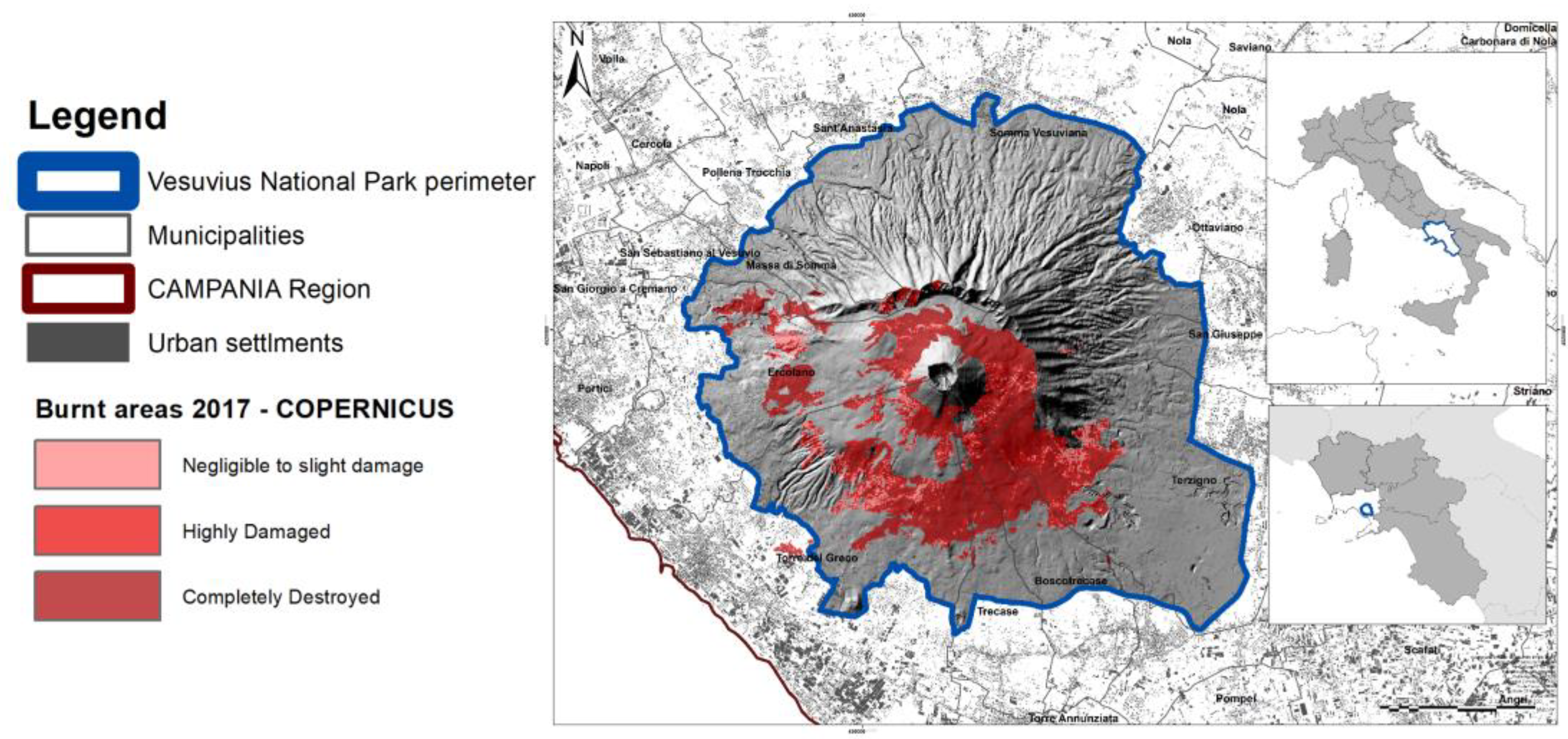
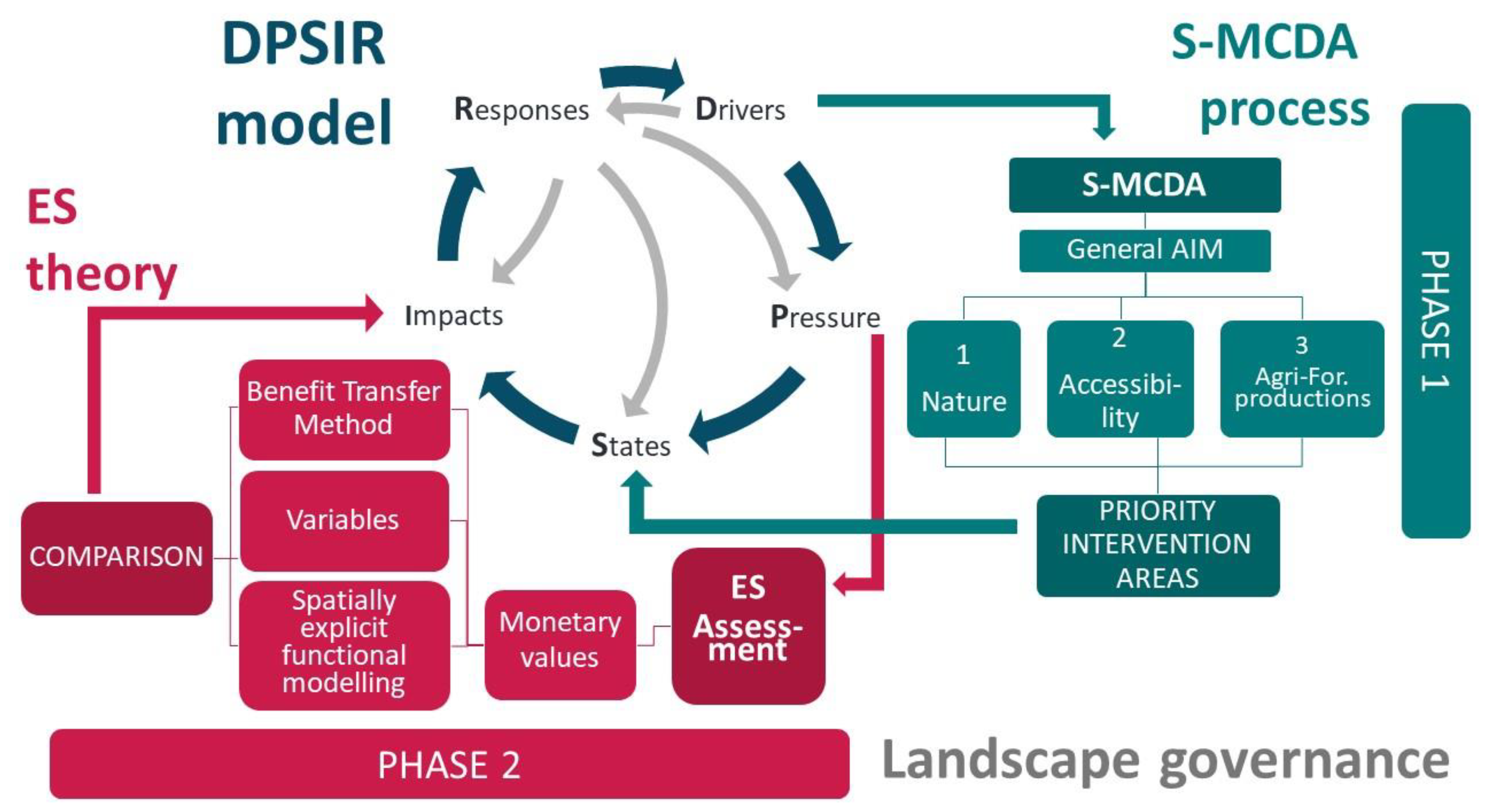
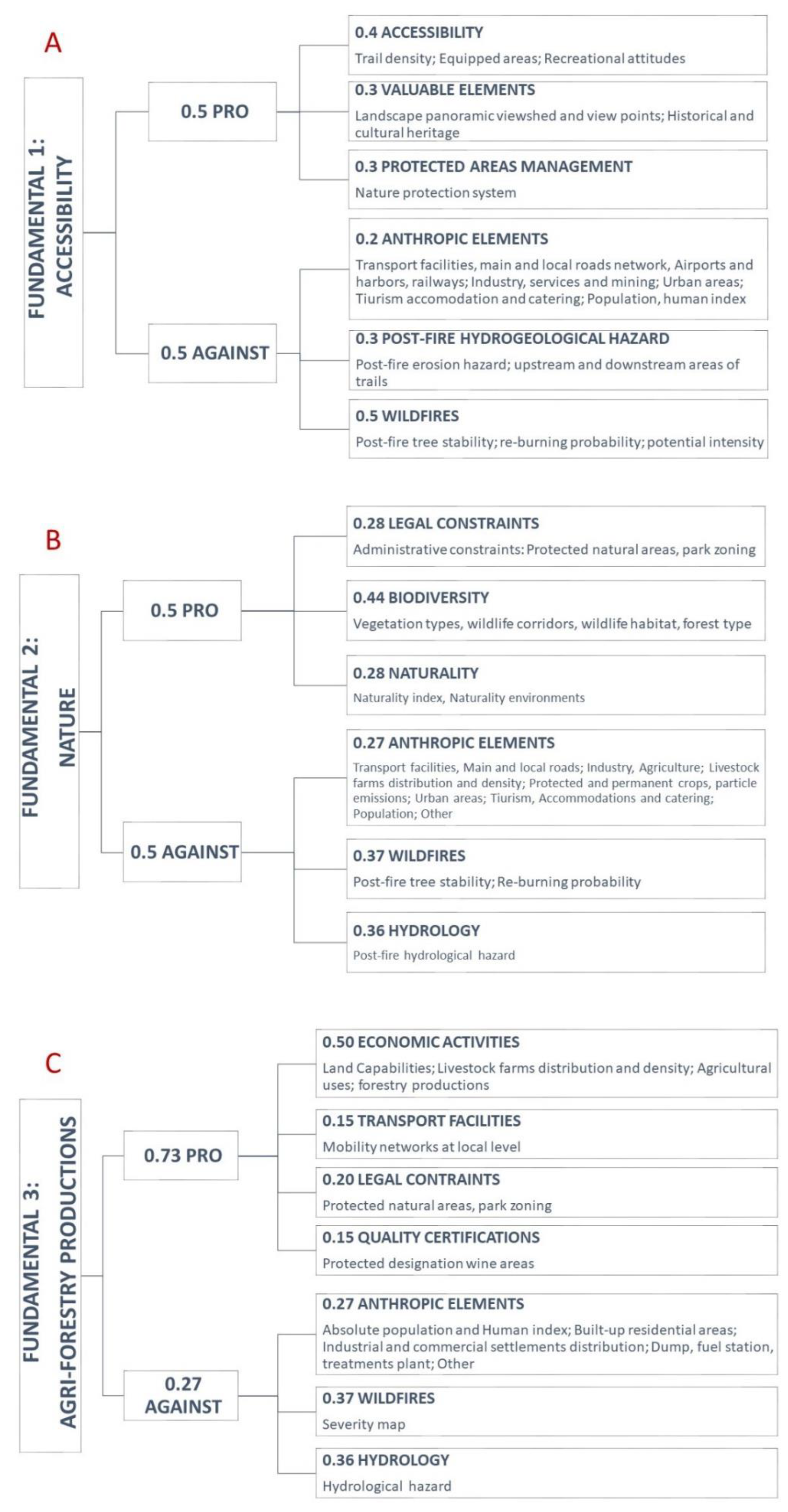
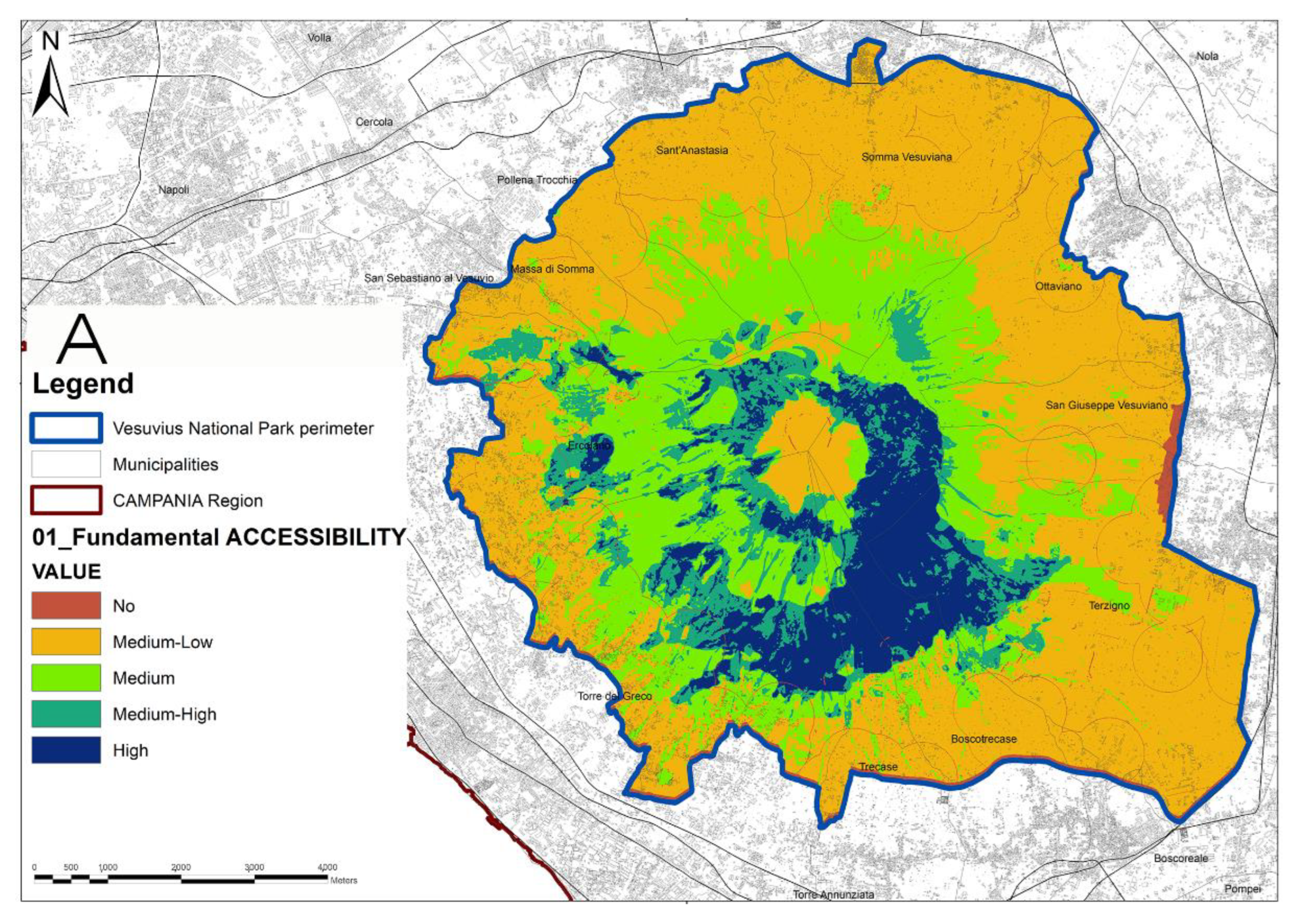

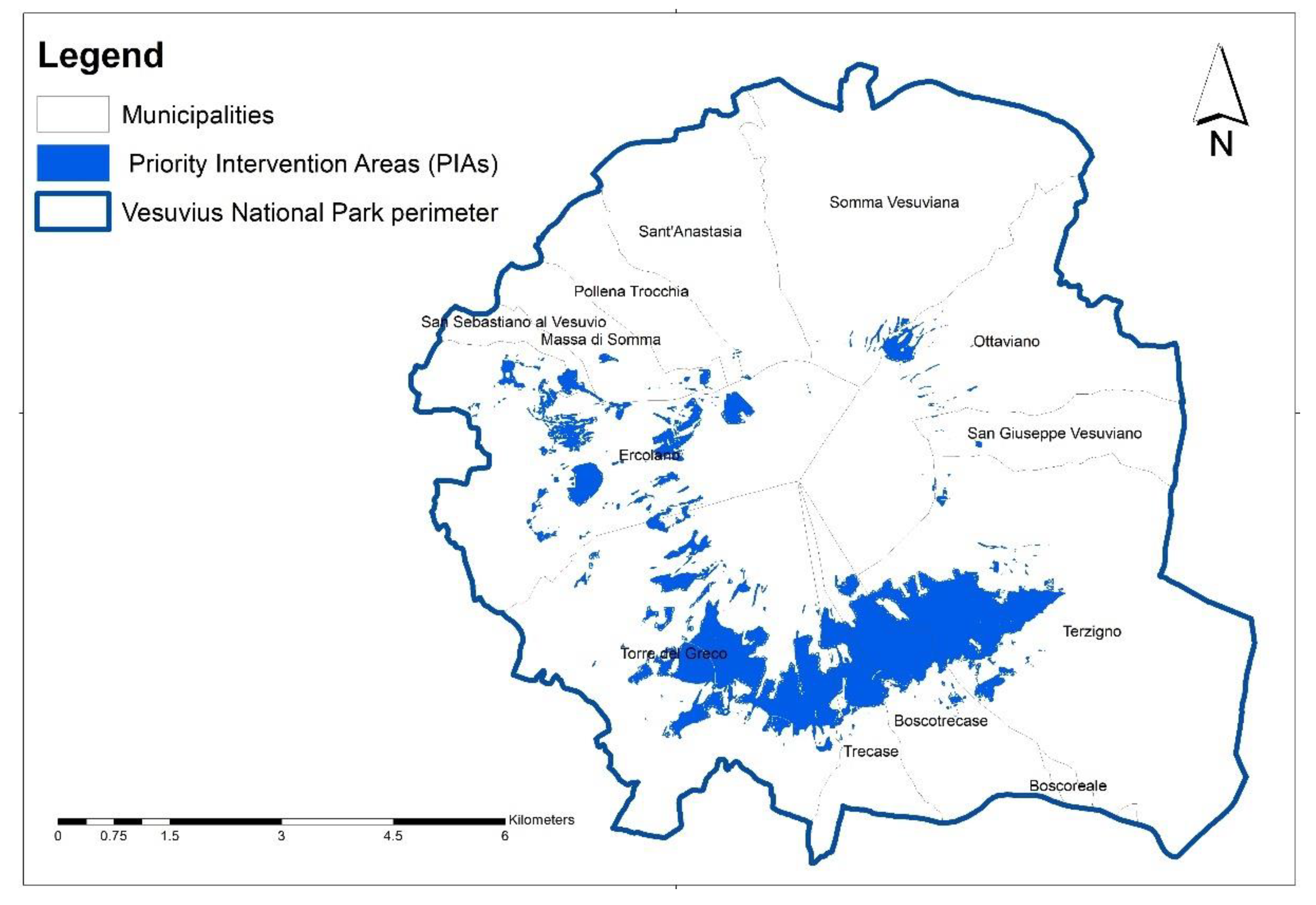
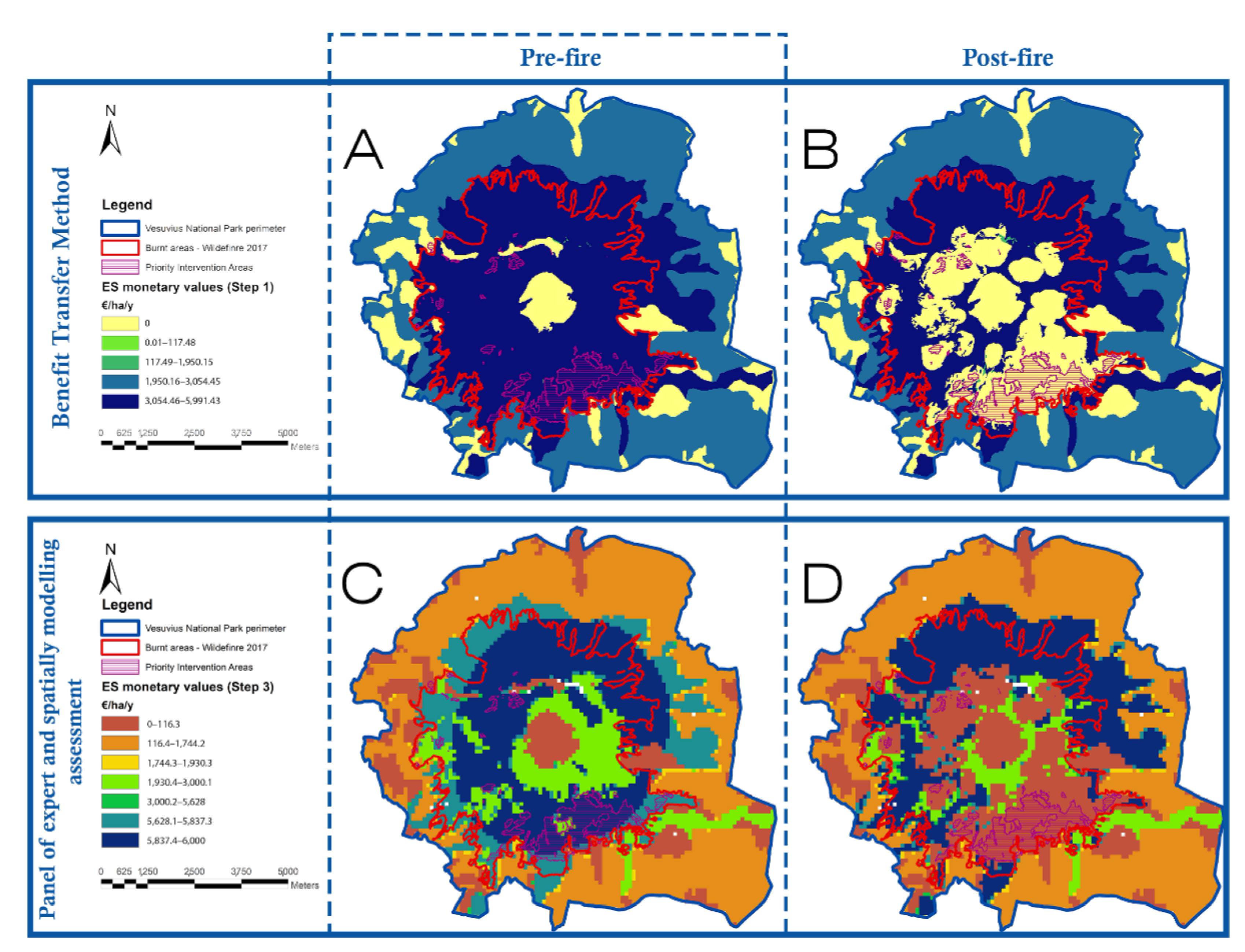

| Ecosystem Service | Climate and Atmospheric Gas Regulation | Disturbance Prevention | Freshwater Regulation and Supply | Waste Assimilation | Nutrient Regulation | Habitat Refugium, and Biodiversity | Recreation | Aesthetic and Amenity | Soil retention and Formation | Pollination | TOTAL |
|---|---|---|---|---|---|---|---|---|---|---|---|
| Land Cover Class | €/ha/y | ||||||||||
| Cropland | 24.10 | 0.00 | 60.78 | 0.00 | 151.96 | 1622.30 | 29.24 | 32.96 | 4.16 | 32.09 | 1957.60 |
| Pasture | 7.86 | 0.00 | 3.14 | 79.65 | 0.00 | 0.00 | 2.10 | 1.05 | 5.24 | 25.15 | 124.19 |
| Forest | 129.95 | 170.82 | 4179.42 | 79.65 | 332.22 | 659.54 | 112.62 | 1.58 | 9.48 | 316.14 | 5991.43 |
| Urban green | 653.22 | 0.00 | 10.48 | 0.00 | 0.00 | 0.00 | 4830.23 | 0.00 | 0.00 | 0.00 | 5493.93 |
| Fresh-water wetland | 243.14 | 6650.61 | 4241.78 | 1523.79 | 222.18 | 84.23 | 1372.88 | 3651.23 | 0.00 | 0.00 | 17,989.83 |
| Salt-water wetland | 122.62 | 1.05 | 1752.26 | 7104.39 | 0.00 | 301.82 | 31.44 | 229.51 | 0.00 | 0.00 | 9543.09 |
| Fresh-water | 0.00 | 0.00 | 670.72 | 610.98 | 0.00 | 0.00 | 717.88 | 135.19 | 1118.22 | 0.00 | 3252.99 |
| Herbaceous | 68.90 | 85.41 | 2091.28 | 79.65 | 166.11 | 329.77 | 57.36 | 1.32 | 7.36 | 170.65 | 3057.81 |
| Rock | 0.00 | 0.00 | 0.00 | 0.00 | 0.00 | 0.00 | 0.00 | 0.00 | 0.00 | 0.00 | 0.00 |
| Urban | 0.00 | 0.00 | 0.00 | 0.00 | 0.00 | 0.00 | 0.00 | 0.00 | 0.00 | 0.00 | 0.00 |
| Context | Area | Total ES Step 1 | Total ES VALUES Step 3 | ||
|---|---|---|---|---|---|
| (ha) | (€/y) | (€/y) | |||
| PRE-Fire Phase | POST-Fire Phase | PRE-Fire Phase | POST-Fire Phase | ||
| Park | 8264.00 | 28,126,290.60 | 21,266,454.90 | 26,501,959.80 | 19,886,809.60 |
| Burnt areas | 3131.30 | 15,431,086.60 | 8,605,555.00 | 14,785,670.30 | 8,221,023.70 |
| Priority Intervention Areas | 660.40 | 3,906,415.10 | 763,075.70 | 3,694,018.50 | 732,417.30 |
Publisher’s Note: MDPI stays neutral with regard to jurisdictional claims in published maps and institutional affiliations. |
© 2022 by the authors. Licensee MDPI, Basel, Switzerland. This article is an open access article distributed under the terms and conditions of the Creative Commons Attribution (CC BY) license (https://creativecommons.org/licenses/by/4.0/).
Share and Cite
Cervelli, E.; Pindozzi, S.; Allevato, E.; Saulino, L.; Silvestro, R.; Scotto di Perta, E.; Saracino, A. Landscape Planning Integrated Approaches to Support Post-Wildfire Restoration in Natural Protected Areas: The Vesuvius National Park Case Study. Land 2022, 11, 1024. https://doi.org/10.3390/land11071024
Cervelli E, Pindozzi S, Allevato E, Saulino L, Silvestro R, Scotto di Perta E, Saracino A. Landscape Planning Integrated Approaches to Support Post-Wildfire Restoration in Natural Protected Areas: The Vesuvius National Park Case Study. Land. 2022; 11(7):1024. https://doi.org/10.3390/land11071024
Chicago/Turabian StyleCervelli, Elena, Stefania Pindozzi, Emilia Allevato, Luigi Saulino, Roberto Silvestro, Ester Scotto di Perta, and Antonio Saracino. 2022. "Landscape Planning Integrated Approaches to Support Post-Wildfire Restoration in Natural Protected Areas: The Vesuvius National Park Case Study" Land 11, no. 7: 1024. https://doi.org/10.3390/land11071024
APA StyleCervelli, E., Pindozzi, S., Allevato, E., Saulino, L., Silvestro, R., Scotto di Perta, E., & Saracino, A. (2022). Landscape Planning Integrated Approaches to Support Post-Wildfire Restoration in Natural Protected Areas: The Vesuvius National Park Case Study. Land, 11(7), 1024. https://doi.org/10.3390/land11071024









